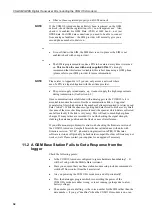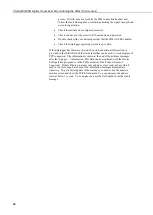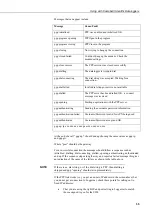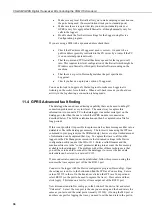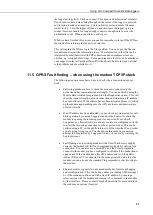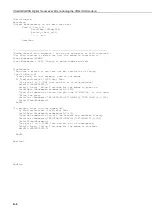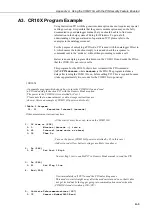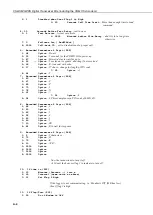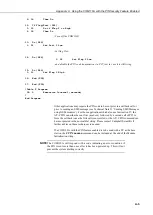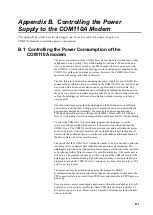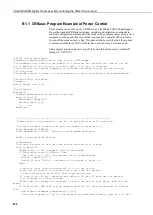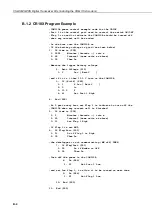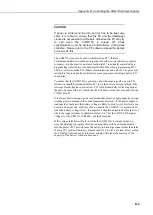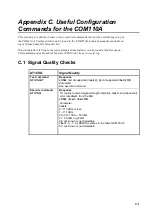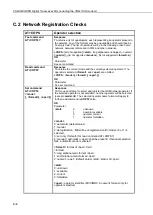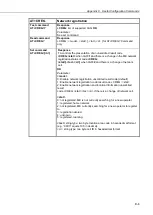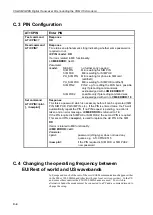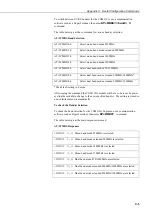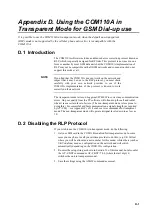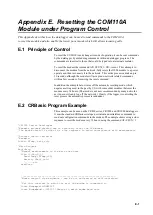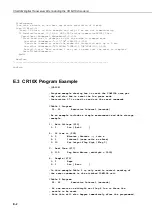
B-1
Appendix B. Controlling the Power
Supply to the COM110A Modem
This Appendix describes how the datalogger can be used to control the power supply to a
COM110A modem to minimise power consumption.
B.1 Controlling the Power Consumption of the
COM110A modem
The power consumption of the COM110A system is much lower than many other
cellphones, being typically 5 mA while waiting for calls and <200mA when on-
line. As an option a power switch or the SW12 output (if free) can be used with
the COM110A, which allows the datalogger to turn off the power supplied to the
COM110A and thereby minimise power use. However, the COM110A will not
answer any incoming calls when in this state.
The first thing to consider when designing the power supply for your COM110A
system is the possibility of only switching on the COM110A for, say, one hour per
day, during which time a base station can be synchronised to collect data. The
lowest overall power consumption can be obtained by making the datalogger turn
the power on only when it makes outgoing calls. However, this would prevent you
calling the datalogger at will from a base station to check its status or to load a
new program.
Once the total time per day that the datalogger will be turned on in its different
power states is determined, a daily power consumption can be estimated and the
power supply designed accordingly. For most typical remote applications a
PS100E and a medium-sized solar panel will suffice. Please refer to Technical
Note 12 (Calculating Power Consumption and Solar Panel Size) for further details.
To allow the COM110A to receive calls, program the datalogger to set the
relevant control port high which controls the power switch which will turn the
COM110A on. The COM110A will not answer an incoming call when the power
control line is low. Control is normally done using the datalogger instruction (If
Time) with the command option to set the port high (after an additional check on
the battery status) or low at specific times.
The period that the COM110A is switched on needs to be long enough to allow an
incoming call to be started, data collection made and the call completed. The
dataloggers allow an extra refinement to this sequence, which allows the ‘on-time’
to be reduced further. This is because it is possible to monitor if the comm port is
still active. The program can then be written to turn off the COM110A only if the
datalogger is not communicating. The following sequence could be included in a
program to turn on the COM110A for 5 minutes every hour, but only turn it off if
a call is not in progress.
The power can also be switched when using the modem for GPRS
communications but extra steps should be added to the program to shut down the
PPP connection before power-off (use PPPClose) and to renable it (PPPOpen), on
power-up.
For extreme low power consumption applications where the modem has to be left
powered on it is possible to disable the status LED which will save a further 1-2
mA power use on average. Please contact Campbell Scientific for further details
on how to do this.
Summary of Contents for COM110A
Page 2: ......
Page 4: ......
Page 6: ......
Page 10: ......
Page 48: ...CS GSM GPRS Digital Transceiver Kits including the COM110A modem 38...
Page 54: ......
Page 60: ......
Page 66: ......
Page 68: ...CS GSM GPRS Digital Transceiver Kits including the COM110A modem D 2...
Page 72: ......
Page 75: ......


